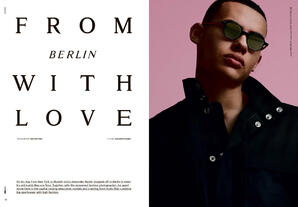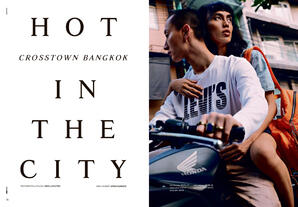
Shubhankar Ray, Global Brand Director, G-Star
Shubhankar Ray is not only renowned for his groundbreaking work as a marketing and image strategist for Caterpillar in the 1990s and Camper in the 2000s, but also for his well-rounded commentaries in interviews. J'N'C editor-in-chief Ilona Marx was able to meet him for a conversation about the topics of globalisation, the changing market for consumer goods and the potential role of fashion labels in world politics.
Tell me about the work on the G-Star Raw for the Oceans project with Pharrell. What’s it like working in these unchartered waters?
It takes a lot, because it’s such a complicated, multi-stakeholder project. I don’t know of many multi-stakeholder projects in this type of collaboration. Normally, in this kind of project, it’s one guy with another guy. It’s never five different stakeholders.
Here we have G-Star, Pharrell, Parley for the Oceans (the ocean charity), Vortex, which is a combination of NGOs that does the ocean cleaning, and Bionic who make the yarn and supply it to G-Star.
Then there is another layer added, because Pharrell is a 30% stakeholder of Bionic. So Pharrell is not only the creative accelerator, and the face of the campaign - he also gives design input and he is a business partner of G-Star. That kind of relationship is basically unheard of.
How did you meet Pharrell and Bionic?
We met them at Bread & Butter in Berlin. After that, we were invited to attend some talks by the world’s leading ocean scientists. Initially, Bionic just wanted to sell the yarn to G-Star, but we decided to develop a different kind of project: to make the world’s first denim out of recycled ocean plastic.
We also wanted to involve Pharrell in the design process and collaborate with him as an accelerator. To us, it was important to create a system in which the sale of the product generates donations that flow back into the ocean clean-up. That’s a very complex project to put into action.
For G-Star, this project has put sustainability at the centre of doing business rather than being a responsibility. Only a few years ago, when we last talked, the percentage of sustainable material used in G-Star was two percent. Now it is 21 percent.
That’s a dramatic shift for the whole brand. We wanted to make real sustainable design. For us, making a product from post-consumer waste is the ultimate sustainable design.
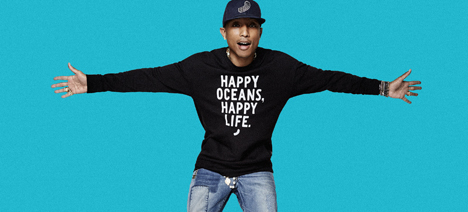
Pharrell für G-Star Raw for the Oceans
Do you have any figures regarding the positive effects your project is having on the oceans?
We have a rough estimate for the first collection, autumn/winter 2014. Its positive result was the waste-reduction of the equivalent of 700,000 plastic bottles. We've averaged the weight of a bottle at 0.5 of an ounce, which thejn adds up to about 10,000 tonnes of plastic waste.
The first container came from cleaning beaches in Indonesia and Bali, the next one for 2015 is coming from China.
You’ve done so much environmentally, do you think fashion brands can also have an impact in terms of political problems or religious tension?
I think it’s very difficult for a fashion brand to comment on issues like that, especially when it comes to religious fundamentalism. We can be the change we want to see in the world in terms of environmentalism. But politics and religion are a different matter.

Pharrell for G-Star Raw for the Oceans
Advertisements - I'm thinking for example Benetton here - can make that kind of statement.
We can change the product and thus the impact the product has on the world, but it’s not our place to get involved in politics.
It is interesting that you mention Benetton, because I have met Oliviero Toscani. Before I went to work for Camper, I was approached by Benetton and went to see Oliviero in La Fabrica. And I remember thinking at the time that Benetton had the beginnings of a cultural brand and not a fashion brand. They were impacting on culture, they had a magazine and their provocative statements and I thought that was great. On top of of this, they had a traditional Italian knitting business, a family business, making relatively simple products like coloured jumpers. I thought that was a very good business model.
They definitely had an impact on me in terms of what I was then going to create for Camper. I was more open to these tactics and also more open to sustainability being at the centre of a strategy, not at the side.
And now, back to your question: I think there are some brands in fashion whose product is a cultural icon. I can think of two products that are like this: jeans and sneakers.
So if anybody in the jeans and sneakers business can transform their product into more meaningful cultural brands, they can create meaningful cultural output. In that situation you could make that kind of commentary on religion or politics.
And G-Star has that potential I think, what about you?
Maybe, but we're politics-neutral. Luciano Benetton and Oliviero Toscani, when I met them, were not. The Veneto, the region they are from, was a hotbed of socialism in Italy, because there were a lot of factories there. So they had a lot unions and a lot of left-leaning politics. Oliviero and Luciano took a stance. So they were able to comment on this, because they were not politics-neutral.
Who could do something like this today?
I think politics today is a lot like branding. Some of the government models of the USA and of Western Europe are similar to the branding of a label. If they were to form a coalition of say Germany, France and the UK and they built an entity whose prime function was to act like a brand, but in this case they don’t sell products, instead they act as a cultural brand or label, then they could comment on these issues and communicate with the people. That would be the way to do it. In an ideal world! (laughing)
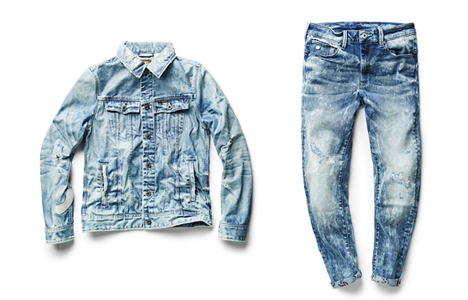
G-Star Raw for the Oceans
Okay, let’s get back to fashion then (laughing). Fashion is becoming increasingly mature and sophisticated with suit styles for men and women. What is G-Star's answer to this development?
To remain true to denim. It’s interesting you mention this. Because yes, I see this development, but I also see the reverse. The big, influential design luxury labels are all pushing denim now, too. Look at Tom Ford. He’s known for his fragrances, sunglasses. But now he’s launching denim. Prada just launched their denim line. I think that denim is on a comeback and because it’s so universal, it energises the marketplace for the consumer.
So the casual brands are making suits now and the high fashion brands are doing denim. Is everyone just looking for their fortune?
I think it’s more because there are no boundaries anymore. Before, you had discreet boundaries that separated different parts of the market. So just like globalisation breaks down the boundaries and everything moves freely around the world - including terrorism, by the way - you have a breakdown of boundaries in shopping because of online shops.
So it’s natural that the marketplace for products would break down in a similar way and that these former borders no longer exist. It is therefore legitimate for a design brand to do denim and for a denim brand to do blazers.
And what about the trend of taking denim as a material for haute couture?
Denim can be used at high or low levels. But the essence of denim for me is democratic, rooted in the street. Occasionally you can elevate the democratic material to a high luxury level if you can add in craftsmanship, something that is artisanal and very specialised. Then yes, you can elevate denim to couture level. Because the material is very flexible, that means it can exist in any dimension, like the dimension of a tuxedo jacket or even an Oscar dress.
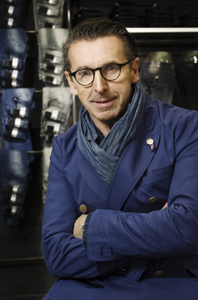
Pierre Morisset, Craetive Director at G-Star
Last time the two of us talked, together with Pierre Morisset, G-Star’s Creative Director, he told me he was fascinated about the 1920s. We also spoke about customising denim. Did you follow up these ideas?
Yes, for the next season one of our focus areas is repairing: we will be concentrating on how to mend and fix jeans. That, in a way, is recycling, too. We call it the ‘Art of Mending’. So yes, we definitely did follow that up.
After our last talk I expected more twenties dresses from G-Star! (laughing)
At the core of G-Star are jeans. So the thing we have to have locked down first is jeans and jeans culture. The fact is that our women’s line has much more potential than we are currently using. So we want to concentrate first on our women's line. That’s our first priority. Then later, if you can knock out a few twenties dresses, it’s all good. But these are accents, not the core. And we want to focus first on the core.
Thank you for talking to us.




